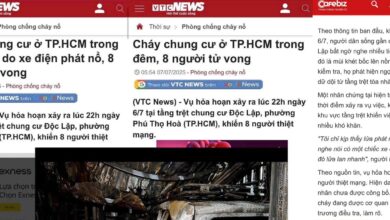
As Vietnam tries to position itself as an essential part of the global semiconductor supply chain, there is no shortage of training, but academics and industry insiders warn that quality is needed over quantity.
On March 23, Professor Nguyen Dinh Duc, Chairman of the Council of the University of Technology at Vietnam National University told the newspaper “Education” that his school had ample semiconductor and microchip-oriented training programs at bachelor and master to doctorate levels.
Hanoi University of Science and Technology offers two main majors on semiconductors and seven related to design, production, packaging and testing, as well as semiconductor chip application.
Beyond academia, companies like FPT and government bodies such as the Ministry of Planning and Investment and the Ministry of Education and Training are actively promoting semiconductor industry training in the country.
On March 20, Vietnamese media reported that Prime Minister Pham Minh Chinh received representatives of U.S. semiconductor company Lam Research Group and asked them to work with Vietnamese agencies to invest in the local semiconductor industry and promote human resource training.
However, in spite of the wide choice of training programs, some experts say Vietnam is not focusing enough on the quality of human resources.
In early March, the Vietnamese government asked South Korea’s Samsung to support the goal of training 50,000 engineers for the semiconductor industry by 2030. The Ministry of Planning and Investment said it was looking to submit the project to the government with a goal of extending it to 2045.
“So each year, Vietnam plans to train more than 8,000 engineers. In theory, that goal can be achieved,” said Dr. Trong Tong, a senior expert at the U.S. headquarters of chip giant Intel.
“However, for Intel and me personally, the number of engineers and the field of study of the workers is not as important as their quality.
“Candidates can study any field as long as it is in the engineering field, we will recruit them all as long as that person is capable.”
Dr. Tong worked in the software sector at Intel for eight years building machinery systems for semiconductors.
While his coverage is considered broad, he said that in a chain of about 20 steps covering the entire process he only covers one or two steps, each step always includes both hardware and software to control the machine.
When machines and software are brought into the factory, a large number of people are needed to operate them. He said Vietnamese engineers often only work on machines for the first few years after they have graduated.
“If Vietnam wants to be self-reliant, I guarantee it won’t be possible quickly. … It takes time to accumulate both knowledge and experience. That’s a reality, because it’s so complicated. It’s not as simple as making software,” he told Radio Free Asia.
To recruit at PhD level, Dr. Trong said the subject is not that important.
“You can have a PhD in materials science, a PhD in physics, chemistry, a PhD in electronics, mechanics, or computer science. As long as you have high expertise in a field of science and technology, you can be recruited. If the candidate has expertise in the semiconductor industry, it’s a little better, but basically they still have to be trained from the beginning.
“At Intel, we don’t really care what candidates study. Electronics, materials or chemistry are all fine … We assume that candidates who have graduated from engineering must know basic math, physics, chemistry, have good logical thinking, and we will hire them if they satisfy the company’s requirements.”
Dr. Tong said setting a target of 50,000 semiconductor engineers by 2030 is the wrong way for Vietnam to tackle the skills shortage. He said that target was easily achievable but meaningless unless Vietnam trained people to meet the precise requirements of the semiconductor industry.
From training to production
On March 21, Vietnamese media reported that FPT launched an integrated circuit design training program. In recent years, FPT has successfully designed a number of chip lines.
However, according to Dr. Trong Tong, the journey from chip design to chip production is very long.
He said designing chips now is not difficult since one just needs the software to do it. But once the design is complete, bringing it to production is the problem.
If Vietnam wants to participate, he said, it needs to mass produce chips to lower the product price.
“Maybe Vietnam wants to make chips the way [VinGroup founder] Pham Nhat Vuong makes electric cars, by buying a machine system to make them. But in the semiconductor industry, it cannot be done simply. People cannot buy a system and install it.”
Nguyen Quoc Tri, an independent researcher and journalist in Ho Chi Minh City, told RFA that both political and business leaders as well as many Vietnamese people are excited and optimistic that Vietnam will become a formidable force in the semiconductor industry. According to him, the belief is unfounded.
“In Vietnam, development goals are often politicized, such as cars, 5G and now semiconductors, causing ‘collective hysteria’,” said the researcher.
“Many political and business leaders compete with each other to say Vietnam is about to become a formidable technological force. But the problem is that Vietnam is lacking in foundation: capital, human resources, source technology, infrastructure, etcetera.”
Dr. Trong recalled that in 2023 Intel planned to expand production in Vietnam but abandoned the plan and moved to Malaysia. The reason, he said, is that Malaysia has better infrastructure and human resources for the semiconductor industry.
According to the Financial Times, Malaysia is the “surprise winner” in the electronic chip competition between the United States and China. It said Penang state is considered the “Silicon Valley of the East.”
Translated by RFA Vietnamese. Edited by Mike Firn and Taejun Kang.
Tin từ RFA Read More











